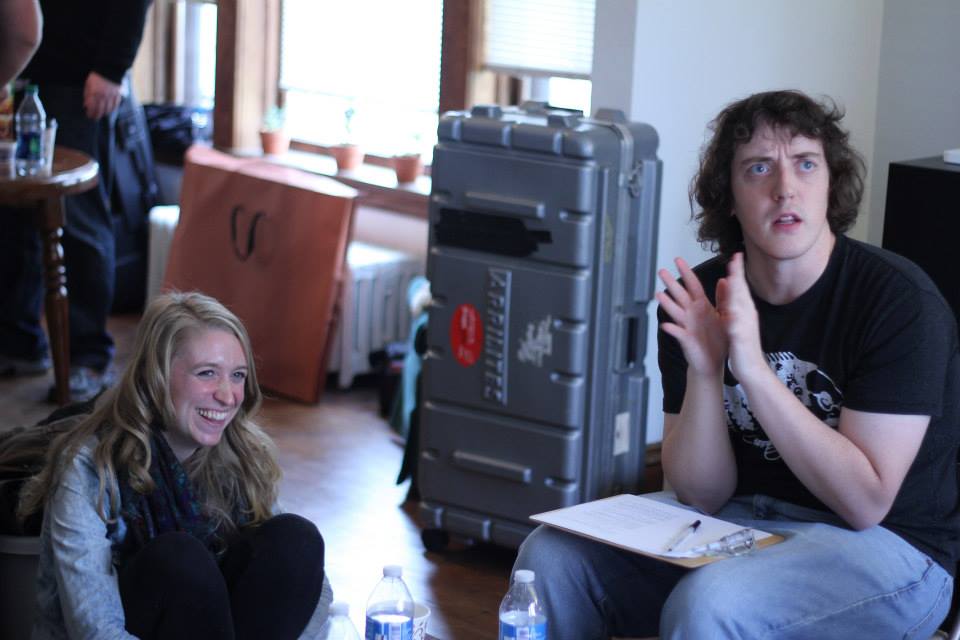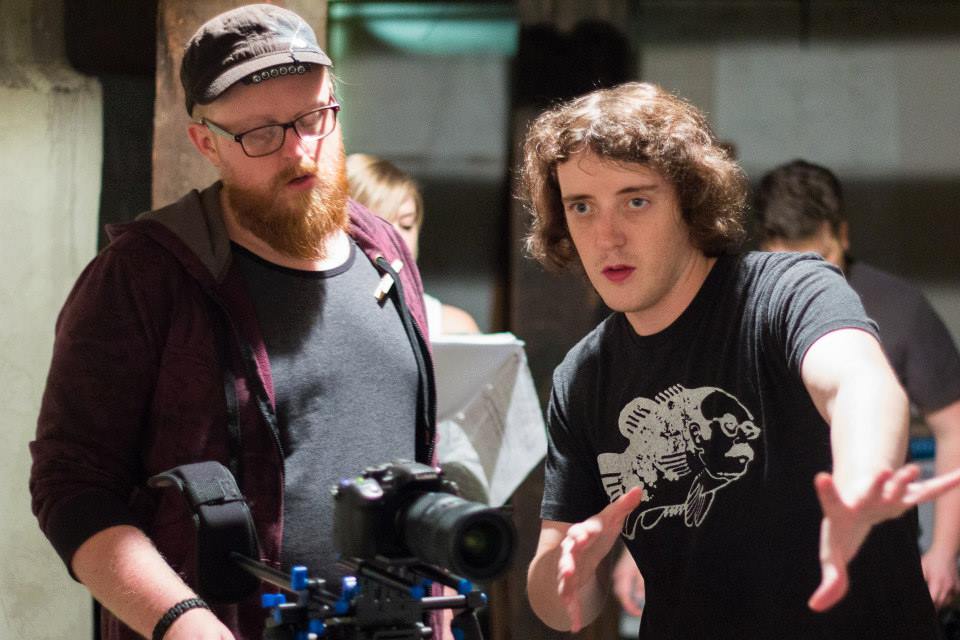How now, lords and ladies? Eric here, as your ghost of film challenges past, with the final installment of our retrospective series!
If you’ve been keeping up with Two Jackets Productions this month, then you’ve noticed we’re feeling nostalgic. This week, Andrew got spooky-scary with his review of All Dressed in White, and Marcus made us all want to go outside and make friends in a retrospective of his one-man-film, The Home Office. Unfortunately, I wasn’t on set or creatively involved in either of these films! To make up for that sad fact, I decided it was high time I direct something. After all, I hadn’t stood at the helm of any film project since A Lutefisk Western way back in 2010!
Luckily, there was one film challenge I hadn’t done since college and was dying to revisit: The Four Points Film Project (formerly the National Film Challenge) - an international free-for-all pitting teams from all over the world against each other in a 72-Hour filmmaking frenzy! Prizes! Glory! A worldwide stage! I said, “We have to do this!”
Marcus and Andrew said, “Yup okay.”
So, we signed up! We gathered a small cast we knew could handle anything we could throw at them, from melodrama to comedy. The roster included Emily King and Allen Voigt, who you may have seen in our short You Only Die Once!, and James Griffin, a local Minneapolis actor we scouted after seeing his fantastic performances in a handful of films. I directed AND shot (more on that later), Andrew produced, and Marcus wrote remotely from Ohio. Check out I Stole a Lot of Money! below:
Was that song about money? I feel like maybe that song had something to do with money.
As with all the other film challenges Two Jackets has been involved with, Four Points assigned us a set of required elements based on our time-zone:
Character: Martin Burley, ATM Technician
Line of Dialogue: “I heard you the first time.”
Prop: A balloon
Genre: Comedy
We were VERY happy with this assignment. The fact that we were given comedy as our genre meant that we knew we could make something silly, and boy did we.
Once we were given the elements via email, Andrew and I video-called Marcus out in Ohio (it’s the future, people!) and had a quick, productive brainstorming session. The planning was so successful because we employed all of the lessons we had learned in previous Film Challenge brainstorms, keeping it to just the three of us and using the required elements as our primary source of influence. Beyond that, we made a rule that I could veto any concept without argument as the director, and Marcus could do the same as the writer. Marcus then led the brainstorming session, and I trusted that he would write something we could produce after we agreed on the concept. Me letting go of the script that night was a huge boon to the production. Within an hour, Marcus was writing, and I was able to get rest for the next day’s shoot.
We ended the film with a visual message instead of dialogue.
As I mentioned in the introduction to this post, I decided that I would shake things up a bit for this competition by taking on the dual role as director and cinematographer. The impetus for this decision was a desire to focus more on visual storytelling. The gang over here at Two Jackets loves (and I mean luuuurrrrves) our dialogue. We’re a wordy group, but I felt that we had been lacking in strong visual storytelling. I thought that by being in charge of the image on screen as well as the performances of our actors, I could simplify the translation from script to screen. I could make all the creative decisions, cut dialogue in favor of blocking and action where I could, and streamline the crew to keep us moving quickly.
It was stressful.
My focus on the cinematography and camera work made it much more difficult to give the actors the attention they deserved from a director. The first scene we shot on Saturday, which involved Emily and James walking along the train tracks, sharing their dreams for what to do with their new-found fortune, was technically very challenging for me as a camera operator. I had to track backwards as smoothly as I could, keeping both actors in frame while trying not to step into a hole or trip over a curb. We tried several times before we finally had a take I was happy with, but what I didn’t realize until reviewing the footage was that the performances I captured were not consistent at all. I gave Emily and James a vague direction about “being happier with their mouths way more open,” and the resulting scene features Emily practically vibrating with giddy excitement while James is dreamily pontificating to the cash gods in the sky. As the director, I should have seen the differences and molded the performances to fit one another. I should have established a strong narrative voice and a consistent rhetoric and tone for the piece. Instead, I was trying not to fall on my ass while operating a camera.
I didn't fall down. On this take.
This was made more difficult by the fact that I didn’t have Andrew or Marcus on set with me to help me catch these mistakes. Marcus, as you know, was in Ohio. Alright fine. There’s nothing I could have done about that. Andrew, however, got stuck in his role as a producer staying with our gear at the location we were using as a home base. We found out when we arrived that we couldn’t keep our equipment inside, and had to protect it from people wandering by outside. I could have used his critical eye on set while I was distracting myself with cinematographer duties. If I had planned better, I could have found a different home base for the shoot, freeing up Andrew to be on set. I realize now that I Stole a Lot of Money! would have benefited greatly from having the entire Two Jackets team present.
I love I Stole a Lot of Money! for being an upbeat, silly, and successful little film (it got into the Top 20 in the worldwide competition!), but it could have been handled better. I was not up for the dual task of shooting and directing, and keeping my best collaborators at arms length meant I was wearing blinders the whole time, unable to see the mistakes I was making. Also, we didn’t have a designated editor at all for this project, which meant Andrew and I were doing everything ourselves, and didn’t have any footage cut together until after we wrapped. This caused me to miss another opportunity to take a critical eye to our work while we still had a chance to reshoot, as we did on Keeping Up with the Cloneses. We were definitely stretching our abilities towards the end of a grueling 72-hour filmmaking marathon.
Directing balloons on very little sleep.
That’s why we’re all going to be in-town and on-set for the 2015 Minneapolis 48 Hour Film Project! I will be acting as cinematographer, and Marcus and Andrew will co-direct. We decided on this configuration as a direct result of our experiences of the last year. Not only did all three of us direct film challenge pieces in 2014, but we all over-reached our grasp. We attempted to do too much without the support of the other two Jackets. In The Home Office, Marcus faced the unique challenge of trying to direct a film while also having to provide the driving performance. In All Dressed in White, Andrew realized that producing the film caused enough stress to affect his ability to also direct it. And in I Stole a Lot of Money!, I learned that operating a camera is distracting enough that I can lose my ability to effectively direct performances.
The job of a director is challenging. It requires the utmost focus. It is often said that a director is a craftsperson who wears many hats on set. She/he must be an actor, a cinematographer, an editor, and a producer all in one. The director must be able to understand every part of the process in order to effectively oversee the creation of a film. However, and I can’t stress this enough, more important than being able to do all the jobs on set is the ability to let go and have someone else do them.
This past year proves that the strength of Two Jackets lies in collaboration. What I think is so unique about this group is that all three of us are storytellers, but we really need to rely on each other so that each member can focus on their particular task. A director can’t do everything themselves. Keeping the vision consistent and the filmic voice strong is the most important thing a filmmaker can do. Allowing oneself to be distracted by other tasks, like shooting, acting, or producing, can be detrimental to the directing process. The film can suffer because of it. We at Two Jackets work well together because we know how to fill in each others’ shortcomings and keep each other focused. For our looming entry to the 2015 48HFP, we are doing as much as we can to ensure that all of our bases are covered. Marcus is focusing on actors, Andrew is focusing on coordinating the crew, and I’m focusing on cinematography. Not only that, but we’re bringing other fantastic talents together to fill in the rest of the gaps (more on that next week!).
Before I leave you, I just want to thank you for watching and for taking this trip with us back in time to film challenges gone by. If you haven’t yet, please take a look at the rest of our Film Challenge Retrospective series, and tune in next week as we explore why we keep coming back for more of these competitions! We’re more excited about this next project than we’d like to admit, and we can’t wait to share the whole experience with you here at TwoJackets.com!











